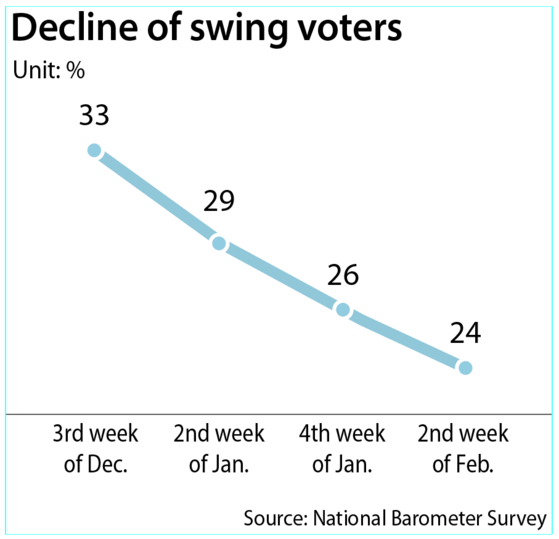Swing voters grow scarce as April elections approach
Published: 20 Feb. 2024, 18:29
![A sign at Seoul’s election commission office in Jongno District, central Seoul, shows that there are 50 days remaining until the April 10 general elections on Tuesday. [NEWS1]](https://koreajoongangdaily.joins.com/data/photo/2024/02/20/d7cb25ab-9406-44f0-a21e-05f170b5cde9.jpg)
A sign at Seoul’s election commission office in Jongno District, central Seoul, shows that there are 50 days remaining until the April 10 general elections on Tuesday. [NEWS1]
According to the telephone surveys conducted by four polling companies over the past weeks, swing voters decreased from 33 percent in December to 24 percent in February.
During the third week of December, 33 percent of the people identified themselves as swing voters in the National Barometer Survey, a biweekly poll jointly conducted by Embrain Public, Kstat Research, Korea Research and Hankook Research. That number went down to 29 percent in the second week of January, 26 percent in the fourth week of January, and 24 percent in the second week of February.
In another poll by Gallup Korea, 27 percent of the respondents identified themselves as swing voters during the first week of December. That number decreased to 26 percent in the third week of January and 24 percent in the third week of February.
In various polls last year, up to 38 percent of the people said they were undecided or supported no particular political party. Still, the trend is clear that swing voters are declining.
According to the National Barometer Survey, more people support major parties such as President Yoon Suk Yeol's governing People Power Party (PPP) and its rival, the Democratic Party (DP).
In the third week of December, 67 percent of the people said they support a political party, including the two main parties. The number grew to 71percent in the second week of January, 74 percent in the fourth week of January and 76 percent in the second week of February.
"Because swing voters do not have a strong preference for a particular political party, they often remain neutral," said Cho Jin-man, a professor of political science at Duksung Women's University. "But they also tend to respond when they have a motive. The decline of swing voters at this particular point indicates that they are responding to each political party."
Swing voters are also comprised mainly of young people in their 20s and 30s. According to the National Barometer Survey, conducted during the second week of February from Feb. 5 to 7, 40 percent of the respondents between 18 to 29 and 39 percent of those in their 30s were swing voters. Among the people over 70, 10 percent were swing voters, while 22 percent of those in their 40s were swing voters.

"Most of the voters in their 20s and 30s are cynical about punishing the administration or the opposition party through an election," said Jeong Han-wool, director of the Korean People Research Institute. "How many of them will respond to each political party's campaign and actually come out to the polling stations to cast a ballot will be a critical factor."
Swing voters are also seen as a decisive factor in the capital region, where 121 out of 253 electoral districts around the country are located. While the PPP's stronghold is the Gyeongsang region and the DP enjoys strong support in Jeolla, Seoul, Incheon and Gyeonggi, voters are relatively less loyal to particular parties.
Races in 39 districts in the capital region during the last general election were decided within 10 percentage points, indicating that swing voters' choices will likely decide the overall victory.
"Swing voters do not vote when particular political issues or politicians do not attract them," said Professor Yoo Sung-jin of Ewha Womans University's Scranton College. "But sometimes, they cast massive votes to a particular party when captivated by a particular agenda. So, the next 50 days will be a war to win the hearts of the swing voters."
Meanwhile, the Korea Broadcasters Association said Tuesday its Korea Election Pool will conduct an exit poll for the April 10 general election. KBS, MBC and SBS will jointly conduct the exit poll at 2,000 polling stations nationwide with 500,000 voters from 6 a.m. to 6 p.m. on election day. The outcome will be announced at 6 p.m. by the three broadcasters.
Media other than the three broadcasters can quote the exit poll later in the evening.
More details of the polls used in this article are available at the National Election Survey Deliberation Commission.
BY KIM HYO-SEONG, SER MYO-JA [enational@joongang.co.kr]










with the Korea JoongAng Daily
To write comments, please log in to one of the accounts.
Standards Board Policy (0/250자)